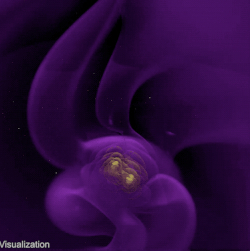 HEAPOW: Gravity - Long May it Wave (2022 Jun 06)
HEAPOW: Gravity - Long May it Wave (2022 Jun 06)
You can picture the Universe as a three dimensional ocean, stirred by random waves of gravity produced by the motions of black holes as they orbit around each other. Ground-based gravitational wave telescopes have detected powerful gravitational tsunamis when black holes (and sometimes neutron stars) catastrophically crash together. The spectacular, Universe-shaking events that have been detected so far involve compact objects that are dozens of times the Sun's mass, or less. Supermassive black hole binary systems millions or billions of times the mass of the Sun produce low-frequency gravitational waves with wavelengths of trillions of miles. Since gravity moves at the speed of light, these long waves take months to pass by. The image above is a single frame from of a movie ot two black holes in orbit, showing in purple the complicated shape of spacetime stippled by gravitational waves. Detecting these long gravitational waves is extraodinarily difficult, and requires a galaxy-sized detector. But fortunately, nature provides them, in the form of arrays of spinning neutron stars distributed throughout the Milky Way. These pulsars have extremely accurate spin periods, rivalling the precision of atomic clocks. A gravitational wave can cause the pulse period to increase or decrease by an extremely tiny amount, and these changes can be used to show that a gravitational wave is rolling on by, and where it came from. One such effort is called NANOGrav, the North American Nanohertz Observatory for Gravitational Waves. NANOGrav monitors a set of radio pulsars, searching for evidence of gravitational waves, and, while it has not detected any so far, it has established some interesting limits on the gravitational wave background roiling the Universe. Scientists have shown that monitoring the gamma-ray emission from gamma-ray pulsars provides a complementary way to look for very long-wavelength gravitational waves. The Fermi Gamma-ray Space Telescope has been scanning the Gamma-ray sky since 2008, providing an extremely rich archive of gamma-ray pulsar measurements. A recent analysis of these data for long gravitational waves has achieved a sensitivity comparable to the radio pulsar timing arrays. With time, these "pulsar timing arrays" become more and more sensitive to long gravitational waves - so please be patient.
NASA: Fermi Hunts for Gravitational Waves from Monster Black Holes
GMS: Gravitational Wave Simulations of Merging Black Holes
A Gamma-ray Pulsar Timing Array Constrains the Nanohertz
Gravitational Wave Background ~ FERMI-LAT Collaboration, M. Ajello et al
- Science 376(6592):521 (07 Apr 2022) DOI: 10.1126/science.abm3231
- arXiv > astro-ph > arXiv:2204.05226 > 11 Apr 2022
| << Previous HEAPOW | High Energy Astrophysics Picture of the Week | Next HEAPOW >> |